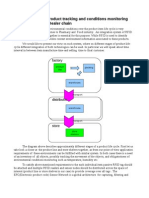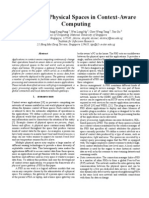Study of CEP-Based RFID Data Processing Model
Study of CEP-Based RFID Data Processing Model
Uploaded by
Md. Abdullah Al NomanOriginal Description:
Original Title
Copyright
Available Formats
Share this document
Did you find this document useful?
Is this content inappropriate?
Report this DocumentCopyright:
Available Formats
Study of CEP-Based RFID Data Processing Model
Study of CEP-Based RFID Data Processing Model
Uploaded by
Md. Abdullah Al NomanCopyright:
Available Formats
Second International Symposium on Intelligent Information Technology Application
Study of CEP-Based RFID Data Processing Model
Guangqian Zhang, Li Zhang The institute of system engineering and researching, Dalian University of Technology, Dalian, Liaoning, 116026, China zhgq@dlut.edu.cn, realamd@126.com Abstract
More and more real time applications apply RFID technology to identify, track and locate objects. Wide deployment of RFID readers will generate an unprecedented volume of primitive data in a short time. Duplication and redundancy of primitive data will affect real time performance of application. Thus, emerging applications must filter primitive data and correlate them for complex pattern detection and transform them to events that provide meaningful, actionable information to end applications. In this paper, we design and develop a complex event processing system called BCEPS. BCEPS will process RFID primitive data and event and perform data transformation. We design a simple complex event language for such transformation. For enhancing real time performance of application, we also design a priority-based event scheduling algorithm for event processing. We apply BCEPS to RFID-based tracking and locating system underground mine which we develop and illustrate the results. Primitive data may be duplicated and in conflict each other. So how to process conflicted data and filter duplicated data to avoid generating invalid or conflicted event is important to save storage spaces and improve performance of system; 2) because of the limitation of RFID readers expression and logic complexity of applications, RFID reader only generate the primitive event that can not meet the real world requirement. However, applications require meaningful and actionable information. Thus, how to transform RFID data and generate complex event meeting the actual application requirement is important for functionality of system. It is proved that the newly complex event processing system has solved the discussed challenges above. Some CEP systems such as SASE[3] have been designed for RFID information transformation.
1.2. Our Motivation
RFID has been applied to the underground mine to track, real-time monitor miners activities as well as control the access to the laneways. Therefore RFID-based tracking and locating system underground mine will face the challenges above. Figure 1 presents the Framework of RFID-based tracking and locating system underground mine (RTLSUM). There are two phases in the framework: Phase 1 is to process primitive data stream gathered by RFID readers and then generate primitive events. This phase aims to solve information conflict and eliminate information redundancy so that it will improve the performance; Phase 2 integrates the primitive events generated in phase 1 into meaningful and complex events that meet actual application requirement. This phase is used for semantic data composition.
1. Introduction
1.1. Background
RFID Radio Frequency IDentification as a new real-time monitoring technology has its own characteristics that differs from other real-time monitoring technology. RFID can collect real-time information and detect real-time event automatically. However, this technology presents the following challenges: 1) RFID reader could gather large quantity of primitive data that causes numerous primitive events.
978-0-7695-3497-8/08 $25.00 2008 IEEE DOI 10.1109/IITA.2008.213 254
Authorized licensed use limited to: Feng Chia University. Downloaded on January 9, 2009 at 04:30 from IEEE Xplore. Restrictions apply.
Figure 1 Framework of RTLSUM
1.3. Our Contribution
In our paper, we design and develop a basic CEP system called BCEPS system which has a priority-based event scheduling algorithm because RTLSUM system requires high real time performance. BCEPS has two main functionalities: The first functionality is to process (abnormally filtering, eliminating duplication and so on) primitive data stream and generates basic primitive events; in light of complex logic of application, the second functionality is union the primitive events into expressive complex events. A prototype of BCEPS will demonstrated through a RTLSUM deployment.
event (reader ID, tag ID, Tstart, Tend, interval) where reader ID represents the reader which exists in the event, tag ID represents the tag which exists in the event, Tstart represents the start time of the event, Tend represents the end time of the event, interval represents the continuous time of the event.
3. Complex event definition
The elementary RFID events, such as primitive ones or basic ones, are far from expressive for practical applications such as business work-flow or real-time monitoring system. Thus RFID processing engine needs to introduce a specific semantics for RFID complex events definition. According to the requirement of RTLSUM system, we define BCEPS complex event language.
2. RFID data stream definition
Numerous RFID data gathered by RFID reader can provide large quantity of potential information, but redundancy and duplication of RFID data could reduce the benefits and even yield contrary effects. So an urgent challenge of RFID event processing is effective and lossless data filtering. Lots of solutions of data filtering have to balance the data volume against data accuracy and system agility. Thus, we define the basic format of RFID data stream to avoid redundancy and duplication.
3.1. Complex event language
For convenience of studying, we define complex event language that is similar to SQL. We will illustrate the whole structure of complex event language: SELECT [result] FROM [event stream] LIKE [EVENT] WHERE [condition] BETWEEN [Tstart, Tend] The semantics of the language are briefly described as follows: SELECT clause transforms the stream of events into composite events and then returns results which meet the requirement of composite events. FROM clause indicates the input event stream. LIKE clause executes event pattern matching between input event stream and EVENT. WHERE clause imposes value-based constraints on the events addressed by the pattern. BETWEEN clause specifies a range of time over event matching. LIKE, EVENT, WHERE and BETWEEN clause s constitute event matching block which transforms a stream of input events stream to a stream of new composite event.
2.1. Primitive RFID data stream
Primitive RFID data stream is generated by RFID reader such as read ID, tag ID and so on. The attributes of objects of system are retrieved in light of primitive RFID data stream. For example, you can get basic information of employee tagged with RFID tag.
2.2. Primitive events
The primitive events of RFID system are the foundation of application, which are generated by physical RFID readers. The event format is like:
4. BCPS architecture
255
Authorized licensed use limited to: Feng Chia University. Downloaded on January 9, 2009 at 04:30 from IEEE Xplore. Restrictions apply.
The architecture of BCEPS system is illustrated in Figure 2. The entire system consists of five layers. The bottom layer is Device Layer that contains RFID readers which detect RFID tags and gather RFID data. The layer above Device Layer is Data Stream Processing Layer which is responsible for processing primitive RFID data according to some RFID rules and generating primitive events. The primitive events are then fed to Event Processing Engine that is the core of the BCEPS system. Event Processing Engine uses event constructor to produce complex events and then Event Processing System processes event stream to deliver the results into RFID Database which is based on PostgreSQL Database in Data Storage Layer. Users can use computer to deliver GUI Event to Event Processing Engine and then get the results from Event Processing Engine. The following are the details about the five layers.
processing copes with idiosyncrasies of readers and performs data cleaning, such as filtering and smoothing. This is important as RFID readings are known to be inaccurate and lossy. Some technologies are available in [5]. After data are processed, Data Stream Processing Layer will generate primitive event in light of the data and hand in the event to Event Processing Engine. Data Stream Processing Layer consists of the following steps, as illustrated in Figure 3.
Figure 3 Data stream processing layer
(1) Anomaly Filtering Layer It removes spurious readings and readings that contain truncated ids. (2) Duplication Filtering Layer Data Stream Processing Layer gets primitive data from TDC (Temporal Data Cache, in Figure 4) which is like a queue that pop data from top and push data into bottom. Device Layer may generate duplicate primitive data which have the same reader ID, tag ID and only different timestamp. So the primitive data which has the largest timestamp will be saved and other duplicate primitive data will be discarded.
Figure 2 BCEP system architecture
4.1. Device layer
Device Layer contains RFID readers and RFID tags. In our system, we use high frequency RFID reader (13.45MHz). Miners are tagged with RFID tags from Philips. The tags abide EPC Class1 Generation 1 standard. After system starts, RFID readers are initialized with the default configuration and then scan their reading range in an interval n that is changed manually. Once RFID reader discovers a tag, it will generate a primitive data: (reader ID, tag ID, timestamp) and deliver it into TDC (Temporal Data Cache) in Data Stream Processing Layer.
Figure 4 Temporal data cache
(3) Event Generation Layer It generate primitive event in light of a pre-defined schema. It retrieves attributes (employee no, reader no, label no, timestamp) defined in the schema from RFID database.
4.3 Event processing engine
Event Processing Engine is the core of the BCEP system. It consists of two components: Event Constructor and Event Processing System. Event Constructor retrieves primitive events from Data stream Processing Layer and GUI events from
4.2. Data stream processing layer
For our application system (RTLSUM), Data Stream Processing Layer has two main functionalities: data processing and generating primitive events. Data
256
Authorized licensed use limited to: Feng Chia University. Downloaded on January 9, 2009 at 04:30 from IEEE Xplore. Restrictions apply.
Application. In order to meet the real time requirement of RTLSUM, we express any events in the format: events (type t, event e, priority p), where t represents the type of event which contains type of GUI events and type of primitive events, e represents the event itself and p represents the priority of the event. The larger the value of p is, the higher the priority of the event is. After event constructor finishes, the events generated are fed to Event Processing System. Event Processing System rearranges the events according to the priority of events. The event having higher priority will be processed and return results earlier. For example, there are two events occur: a GUI event A which wants to get the list of miners who are existing underground and a primitive event B which has real time location information and requires to update location information immediately. Event A is expressed in the format of events (GUI, A, pA), Event B is expressed in the format of events (primitive, B, pB), pB > pA. So Event Processing System will process Event B firstly, and then process Event A. This technology will ensure that the real time of the system is higher.
executing one of the events which have the highest priority 10.
Figure 5 Illustration of Event Processing Engine
Although real time monitoring is also a real time event, the priority of real time detecting is higher than real time monitoring so the event of real time detecting will be processed firstly. This events scheduling method arrange event executions more legitimately.
4.4 Data storage layer
Data Storage Layer contains a relational storage media to support query data according to events stream. We use PostgreSQL 8.2 as our DBMS. We have pre-defined some rules in response to some event streams. This method can improve performance of system.
6. Conclusion
In this paper, we design and develop a prototype of BCEPS for processing RFID data stream. In order to enhance real time performance of system, we use a priority-based event scheduling method in the Event Processing Engine of BCEPS to ensure that real time event will be processed earlier. Finally we apply the BCEPS to our RFID-based Tracking and Locating System Underground Mine. Priority-based event scheduling method is a relatively simple algorithm. In the future, we will design an more effective event scheduling algorithm to improve real time performance.
4.5 Application layer
Application layer generates user GUI events. Users can use pre-defined friendly graphic user interface to deliver events to Event Processing Engine. Application Layer also provides separate processes to monitor the results which are returned by Event Processing Engine and shows the results graphically.
Acknowledgement
This work is supported by the doctoral fund of the Ministry of Education (20070141037).
5. Experiment
Our RTLSUM makes use of the BCEPS model to enhance RFID data stream processing and improve real time of the system. Figure 5 contains three screenshots. The left and top screenshot represents a real time monitoring component that show the real time path of miners underground mine, the left and bottom screenshot represents a real time detecting component that gathers RFID data and the right screenshot represents Event Processing Engine. We can observe that Event Constructor receives 7 events and Event Processing System rearranges the 7 events in light of priority and is
References
[1] Jin Xingyi, Lee Xiaodong, Kong Ning, Yan Baoping (2008). Efficient Complex Event Processing over RFID Data Stream. Seventh IEEE/ACIS International Conference on Computer and Information Science. [2] E. Masciari (2007). RFID data management for effective objects tracking. the 23rd Annu. ACM Symposium on Applied Computing, 2007, pp.457-461.
257
Authorized licensed use limited to: Feng Chia University. Downloaded on January 9, 2009 at 04:30 from IEEE Xplore. Restrictions apply.
[3] Daniel Gyllstrom, Eugene Wu, Hee-Jin Chae, Yanlei Diao, Patrick Stahlberg, Gordon Anderson (2007). SASE: Complex Event Processing over Streams,. CIDR, Asilomar, CA, 2007. [4] B. Yijian, T. Hetal, L. Chang, W. Haixun and Z. Carlo (2006). A Data Stream Language and System Designed for Power and Extensibility. the 15th ACM Conf. on Information and Knowledge Management, Virginia, 2006, pp.337346. [5] SHENG WANG, SHAORONG LIU, PEIYA LIU, YIJIAN BAI(2006). Bridging Physical and Virtual Worlds: Complex Event Processing for RFID Data Streams. the 10th Int. Conf. on Extending Database Technology, Munich, Germany, 2006, pp.588607. [6] E. Wu, Y. Diao and S. Rizvi (2006), High Performance Complex Event Processing over Streams. SIGMOD, Chicago, 2006, pp.407418 [7] MIT Auto-ID Lab. EPC network architecture. January 2006. http://autoid.mit.edu/CS/files/3/networkarchitecture. [8] F. WANG, P. LIU (2005). Temporal management of RFID data. the 31st VLDB Conf., New York, 2005, pp.11281139. [9] Zimmer, D. and Unland R (1999), On the semantics of complex events in active database management systems. ICDE, 392-399, 1999. [10] S. CHAKRAVARTHY, V. KRISHNAPRASAD and E. ANWAR (1994), Composite events for active databases: Semantics contexts and detection. the 20th VLDB Conference, Santiago Chile, 1994, pp.10111205.
258
Authorized licensed use limited to: Feng Chia University. Downloaded on January 9, 2009 at 04:30 from IEEE Xplore. Restrictions apply.
You might also like
- TrustworthinessDocument1 pageTrustworthinessKinray Bade67% (3)
- Educational Research Chapter 1 Introduction To Educational Research Gay, Mills, and AirasianDocument41 pagesEducational Research Chapter 1 Introduction To Educational Research Gay, Mills, and AirasianNicolaus Copernicus100% (2)
- Network Packet Sniffer Project SynopsisDocument4 pagesNetwork Packet Sniffer Project SynopsisMallikarjunaNo ratings yet
- Peoplesoft Interview QuestionsDocument31 pagesPeoplesoft Interview Questionsandysusilook@yahoo.comNo ratings yet
- Middleware For RFID Systems: An Overview: Jameela Al-Jaroodi, Junaid Aziz, and Nader MohamedDocument6 pagesMiddleware For RFID Systems: An Overview: Jameela Al-Jaroodi, Junaid Aziz, and Nader MohamedArul Prakasam SNo ratings yet
- 5.chapter 1Document4 pages5.chapter 1thethtet87No ratings yet
- 0810 Etrx Elx801 Iot SampleqbDocument21 pages0810 Etrx Elx801 Iot SampleqbMohammed AhmedNo ratings yet
- Software Requirements Specification RfidDocument14 pagesSoftware Requirements Specification RfidHemanthi ANo ratings yet
- MIMO - A Hybrid Monitor For Embedded Real-Time SystemsDocument8 pagesMIMO - A Hybrid Monitor For Embedded Real-Time SystemsardserNo ratings yet
- Student Examination Attendance System Via Radio Frequency Identification (RFID) SimulatorDocument28 pagesStudent Examination Attendance System Via Radio Frequency Identification (RFID) SimulatorchoppersureNo ratings yet
- RFID Based Employee Attendance SystemDocument22 pagesRFID Based Employee Attendance SystemAnushree Sapre100% (3)
- Case Study: Product Tracking and Conditions Monitoring Over The Producer-Dealer ChainDocument5 pagesCase Study: Product Tracking and Conditions Monitoring Over The Producer-Dealer ChainvoffffkaNo ratings yet
- Radio Frequency Identification (RFID) Based Employee Management System (EMS)Document4 pagesRadio Frequency Identification (RFID) Based Employee Management System (EMS)inventionjournalsNo ratings yet
- Electronic Toll Collection Sysem Based On RfidDocument68 pagesElectronic Toll Collection Sysem Based On RfidUmar Rahamatullah ShareefNo ratings yet
- RFID-An Emerging AIDCDocument4 pagesRFID-An Emerging AIDCapi-27544843100% (1)
- CodeedDocument72 pagesCodeedAbhilashNo ratings yet
- Iot Systems Management With Netconf-Yang: by J.Ann Roseela Ap/EceDocument32 pagesIot Systems Management With Netconf-Yang: by J.Ann Roseela Ap/EceRamesh BoseNo ratings yet
- RFID Based People Management System Using UHF TagsDocument8 pagesRFID Based People Management System Using UHF Tagsvivekk18No ratings yet
- Analysis of Wireless Data Transmission CharacteristicsDocument13 pagesAnalysis of Wireless Data Transmission CharacteristicsBhavik NasitNo ratings yet
- Gateways of Physical Spaces in Context-Aware ComputingDocument8 pagesGateways of Physical Spaces in Context-Aware ComputingDeepak BhallaNo ratings yet
- RFID Based Security SystemDocument30 pagesRFID Based Security Systemletter2lalNo ratings yet
- Implementation of Secured RFID Mutual Authethentication ProtocolDocument6 pagesImplementation of Secured RFID Mutual Authethentication ProtocolAishwarya a nairNo ratings yet
- IPTV SystemsDocument7 pagesIPTV SystemsFidel Gil ValerianoNo ratings yet
- Design and Implementation of Smart Attendance System Based On Raspberry PiDocument6 pagesDesign and Implementation of Smart Attendance System Based On Raspberry PiNedelyn PayaoNo ratings yet
- Integrating Automatic Data Acquisition With Business Processes Experiences With SAP's Auto-ID InfrastructureDocument7 pagesIntegrating Automatic Data Acquisition With Business Processes Experiences With SAP's Auto-ID Infrastructurejay_kay70No ratings yet
- Infra ArchDocument20 pagesInfra ArchPragam KaisthaNo ratings yet
- Ubic ComputingDocument14 pagesUbic ComputingBruno RamirezNo ratings yet
- Cloud 4unitDocument11 pagesCloud 4unitPriya PrakashNo ratings yet
- Physical Design of Iot: Things/DeviceDocument23 pagesPhysical Design of Iot: Things/DeviceShashank chowdary DaripineniNo ratings yet
- Airline Reservation Systems-Project SynopsisDocument23 pagesAirline Reservation Systems-Project Synopsisanusha palasaNo ratings yet
- S Rfid M A S M S: Ecured Utual Uthentication Cheme For Ifare YstemsDocument15 pagesS Rfid M A S M S: Ecured Utual Uthentication Cheme For Ifare YstemsAIRCC - IJNSANo ratings yet
- Simulasi Gerbang Tol Menggunakan RFID (Radio Frequency Identification)Document6 pagesSimulasi Gerbang Tol Menggunakan RFID (Radio Frequency Identification)Sulianto BhirawaNo ratings yet
- 79 - 133 - Book ChapterDocument12 pages79 - 133 - Book ChaptersaravananNo ratings yet
- Iccp GuideDocument57 pagesIccp GuidesistemcbaNo ratings yet
- 03 PresentationDocument38 pages03 Presentation18-QADEER AHMADNo ratings yet
- RFID Based Automated Toll Plaza SystemDocument7 pagesRFID Based Automated Toll Plaza SystemHussnain RazaNo ratings yet
- EHDFchapter 4Document14 pagesEHDFchapter 4Ahmad Raza AnsariNo ratings yet
- Supply Chain Duplicate Transportation RFID Data Stream FilteringDocument10 pagesSupply Chain Duplicate Transportation RFID Data Stream FilteringInternational Journal of Application or Innovation in Engineering & ManagementNo ratings yet
- Data Handling & Analytics: Unit 5Document18 pagesData Handling & Analytics: Unit 5Arun K KNo ratings yet
- Middleware ArchitectureDocument7 pagesMiddleware ArchitectureUmaNo ratings yet
- Analysis and Design For Intrusion Detection System IDS Using Data Mining IEEE 2010Document4 pagesAnalysis and Design For Intrusion Detection System IDS Using Data Mining IEEE 2010fakeacc18No ratings yet
- Implementation of Secure RFID Mutual Authethentication ProtocolDocument6 pagesImplementation of Secure RFID Mutual Authethentication ProtocolAishwarya a nairNo ratings yet
- Smart Id JournalDocument21 pagesSmart Id JournalwahyudiNo ratings yet
- On Detecting Internet-Based Criminal Threats With Xplicoalerts: Current Design and Next StepsDocument5 pagesOn Detecting Internet-Based Criminal Threats With Xplicoalerts: Current Design and Next StepsSergio EspositoNo ratings yet
- Recursive Internetwork Architecture, Investigating Rina As An Alternative To Tcp/Ip (Irati)Document30 pagesRecursive Internetwork Architecture, Investigating Rina As An Alternative To Tcp/Ip (Irati)Fauzan RamadhanNo ratings yet
- Cisco Interview QuestionsDocument8 pagesCisco Interview QuestionsssprudhviNo ratings yet
- Network Traffic Analyzer: Semester 6 ProjectDocument13 pagesNetwork Traffic Analyzer: Semester 6 Projecthunterdii9879No ratings yet
- Use of Rfid at Large-Scale Events: Yuusuke KAWAKITA Yojiro UODocument9 pagesUse of Rfid at Large-Scale Events: Yuusuke KAWAKITA Yojiro UOdinaa221No ratings yet
- Simple Low Cost Iot Uhf Rfid Based Lab Equipment Identification and Tracking SystemDocument16 pagesSimple Low Cost Iot Uhf Rfid Based Lab Equipment Identification and Tracking SystemAgam KurniawanNo ratings yet
- Networking Basics 1Document32 pagesNetworking Basics 1raghuvarunbtech777No ratings yet
- Extension On CUHK RFID Middleware: ERG4920B - FYP Presentation, 2008 - 2009Document15 pagesExtension On CUHK RFID Middleware: ERG4920B - FYP Presentation, 2008 - 2009saqibmaxNo ratings yet
- NETWORKINGDocument13 pagesNETWORKINGraghuvarunbtech777No ratings yet
- Prac 1 ComputerDocument15 pagesPrac 1 Computernicolmanico7No ratings yet
- Dissertation On Wireless Sensor NetworkDocument4 pagesDissertation On Wireless Sensor NetworkDoMyPaperForMoneyDesMoines100% (1)
- An Analysis of Rfid Authentication Schemes For Internet of Things Iot in Healthcare Environment Using Elgamal Elliptic Curve Cryptosystem PDFDocument7 pagesAn Analysis of Rfid Authentication Schemes For Internet of Things Iot in Healthcare Environment Using Elgamal Elliptic Curve Cryptosystem PDFrahul agarwalNo ratings yet
- IOT ArchitectureDocument13 pagesIOT ArchitectureAhmad Raza AnsariNo ratings yet
- Security Management Against Cloning Mobile Phones: Abstract: This Work Presents The Development of A DistributedDocument5 pagesSecurity Management Against Cloning Mobile Phones: Abstract: This Work Presents The Development of A DistributedSricharan ReddyNo ratings yet
- How OSI 7 Layer Model WorksDocument9 pagesHow OSI 7 Layer Model WorksRanjit SinghNo ratings yet
- A Seminar Report On: Rfid TechnologyDocument33 pagesA Seminar Report On: Rfid TechnologyVarun Kumar N M100% (1)
- Rfid Based Attendance SystemDocument4 pagesRfid Based Attendance SystemmveenavijayanmNo ratings yet
- Flowstalker: Comprehensive Traffic Flow Monitoring On The Data Plane Using P4Document6 pagesFlowstalker: Comprehensive Traffic Flow Monitoring On The Data Plane Using P4Angel Nicolas Arotoma PraviaNo ratings yet
- Real-Time Analytics: Techniques to Analyze and Visualize Streaming DataFrom EverandReal-Time Analytics: Techniques to Analyze and Visualize Streaming DataNo ratings yet
- Ldapv 3Document500 pagesLdapv 3galingeo100% (4)
- E-Policing in The PNP Laoag City Police Station Case StudyDocument10 pagesE-Policing in The PNP Laoag City Police Station Case StudyInternational Journal of Innovative Science and Research TechnologyNo ratings yet
- IB Lab - 01 Murphys Law (Pla PLB DC DPP CE)Document2 pagesIB Lab - 01 Murphys Law (Pla PLB DC DPP CE)ringo_tigerNo ratings yet
- Latar BelakangDocument14 pagesLatar BelakangluckyNo ratings yet
- BIAETDocument82 pagesBIAETNicholas JohnNo ratings yet
- Big Data HadoopDocument34 pagesBig Data Hadoopkuldeep singhNo ratings yet
- Methodological Brief - EnG v.2 - 2Document44 pagesMethodological Brief - EnG v.2 - 2Ayah S. YassinNo ratings yet
- Using External Data Integration ServicesDocument101 pagesUsing External Data Integration ServicesJoel D'SilvaNo ratings yet
- Data Structures PresentationDocument59 pagesData Structures PresentationSAI PAVANNo ratings yet
- Ofsdw Ug E29494 01Document242 pagesOfsdw Ug E29494 01ganeshsrinivasan3191No ratings yet
- 1713 - GIS Officer - AdvertDocument3 pages1713 - GIS Officer - AdvertDefi OhfanisaNo ratings yet
- Data Protection Audit Manual - (173p)Document173 pagesData Protection Audit Manual - (173p)Rodrigo BenaventeNo ratings yet
- Penerapan Metode Single Exponential Smoothing Dalam Peramalan Penjualan BarangDocument9 pagesPenerapan Metode Single Exponential Smoothing Dalam Peramalan Penjualan BarangAna Nya AnaNo ratings yet
- Big Data Ibm 2014Document33 pagesBig Data Ibm 2014John DoeNo ratings yet
- Course-Wise Exam Dates For Second Semester of Academic Year 2023-2024Document34 pagesCourse-Wise Exam Dates For Second Semester of Academic Year 2023-2024muzeebur rahmanNo ratings yet
- Experiment 2: A Case Study On Talend Open Source Tool For Data IntegrationDocument2 pagesExperiment 2: A Case Study On Talend Open Source Tool For Data IntegrationkhushiNo ratings yet
- ESTP - Census Hub - 020317Document29 pagesESTP - Census Hub - 020317Haikal FaqihNo ratings yet
- Perbandingan Metode Ahp Dengan SawDocument4 pagesPerbandingan Metode Ahp Dengan Sawrizki ramadanNo ratings yet
- A Practical Guide To Fedora and Red Hat Enterprise Linux, Fifth EditionDocument59 pagesA Practical Guide To Fedora and Red Hat Enterprise Linux, Fifth EditionkrwigonNo ratings yet
- Data Compression For Network GIS: SynonymsDocument6 pagesData Compression For Network GIS: SynonymsVidhya PackirisamyNo ratings yet
- Module2 Ids 240201 162026Document11 pagesModule2 Ids 240201 162026sachinsachitha1321No ratings yet
- Aula 3 - A Proposed Model For Selecting Measurement Procedures (Leitura Básica)Document8 pagesAula 3 - A Proposed Model For Selecting Measurement Procedures (Leitura Básica)Ingrid AndreaçaNo ratings yet
- Lecture1000 6Document93 pagesLecture1000 6rinkygoyalNo ratings yet
- Generative Ai Readiness ReportDocument21 pagesGenerative Ai Readiness ReportAkram QureshiNo ratings yet
- Free Research Paper On Data WarehousingDocument4 pagesFree Research Paper On Data Warehousinggpxmlevkg100% (1)
- Cercul TrigonometricDocument1,380 pagesCercul TrigonometricdumitruionutandreiNo ratings yet
- INNOBIZ Presentation1-6Document13 pagesINNOBIZ Presentation1-6Juan Carlos ZamoraNo ratings yet

























































































